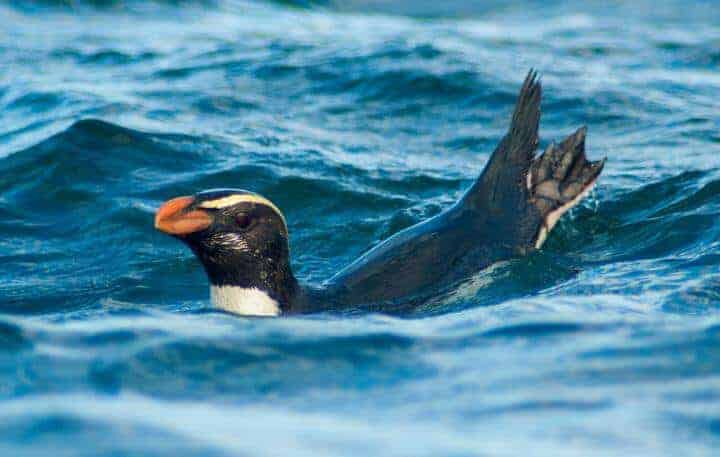Fiordland penguins, Eudyptes pachyrhynchus, known as Tawaki, migrate up to 2,500 km from their breeding site, according to a study publishing August 29 in the open-access journal PLOS ONE by Thomas Mattern of the University of Otago and colleagues.
Tawaki penguins migrate from their breeding sites on the west coast of New Zealand’s South Island, where they feed at sea for several weeks to refuel after long periods of fasting on land while rearing chicks. To find out where the seabirds go, the authors attached satellite transmitters to 10 male and 7 female adult Tawaki penguins from November 2016 to March 2017, and compared the migration routes with published oceanographic data such as surface temperature and currents. Tags on nine birds continued emitting data up until they turned back for the return journey, and five were tracked for the entire migration.
They found that the penguins travelled between 3,500 and 6,800 km on their 69-day migration – making theirs one of the longest penguin pre-moult migrations recorded to date. The birds travelled between 20km and 80km per day – which the authors suggest may be close to the upper limit for penguin swimming.
Penguins travelled south west from the colony before heading to one of two feeding grounds – one near the subtropical front (STF), south of Tasmania, and one further south near the subantarctic front (SAF). Birds that left the breeding site earlier in the season tended to head to the STF, and travelled 750 km shorter on average. The authors suggest that successful breeders may be more likely to depart late because of the demands of parenting, and have to swim faster to reach the more distant feeding grounds in the SAF.
Mattern notes: “The penguins leave the New Zealand coast at a time when the ocean’s productivity is nearing its peak, so from that perspective, travelling thousands of kilometers seem to make little sense. We believe that this extraordinary behavior could be a remnant from an ancestral penguin species that evolved further south in the sub-Antarctic region before populating the New Zealand mainland. This would also explain why the species breeding range is concentrated to the southern coastlines of New Zealand; if breeding further north, this migratory behavior would simply not be feasible.”
###
Peer-reviewed / Observational Study / Animals
In your coverage please use this URL to provide access to the freely available article in PLOS ONE: http://journals.
Citation: Mattern T, Pütz K, Garcia-Borboroglu P, Ellenberg U, Houston DM, Long R, et al. (2018) Marathon penguins – Reasons and consequences of long-range dispersal in Fiordland penguins / Tawaki during the pre-moult period. PLoS ONE 13(8): e0198688. https:/
Funding: Devices and data acquisition costs were covered by the Antarctic Research Trust to TM. This study was funded through grants by the Global Penguin Society, Ornithological Society New Zealand (Birds NZ Research grant), the JS Watson Trust and Forest & Bird Southland to TM. The funders had no role in study design, data collection and analysis, decision to publish, or preparation of the manuscript.
Competing Interests: The authors have declared that no competing interests exist.


